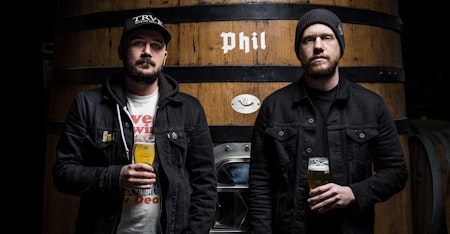With a focus on California fruit and the mindset of a winemaker, Almanac Beer Company’s brewmaster, Jesse Friedman, is turning out sour beers that embrace diversity.
Jesse Friedman, the cofounder and brewmaster at San Francisco’s Almanac Beer Company, met his business partner Damian Fagan at a homebrew club that sampled a variety of homemade and commercially made beers. Friedman, who at the time was working in the technology industry and beer blogging in his spare time, noticed the savvy label on Fagan’s beer and assumed it came from a craft brewing company. As it turns out though, Fagan was a professional graphic designer who put commercial-grade labels on all of his homebrews.
“It was love at first homebrew sight,” Friedman remembers. In 2010 the duo committed to an exclusive brewing relationship when they launched Almanac Beer Company in San Francisco’s Dogpatch neighborhood. In addition to a series of fresh (non-barrel-aged) beers that include a gose, a saison, and an IPA, Almanac produces an impressive lineup of barrel-aged and blended beers from its cellar of 1,700 oak barrels and counting. A number of these barrel-aged beers are sour.
“Every brewery has its own approach to the process and the flavor of sour beers,” Friedman says. “We started by throwing a party where everyone brought [his/her] favorite sour beers. That’s where our homebrew roots come through. We cultured the dregs from those bottles—at least a dozen of them—and added commercial bugs as well.”
Among those favorite sours were beers from Russian River, Brasserie d’Orval, Brasserie Cantillon, and several local California breweries. Friedman and Fagan combined yeast sediments from those beers with “bugs” such as sourdough yeast and Brettanomyces to create their house culture. After a mixed primary fermentation, the sour beers at Almanac age and ferment further in barrels gaining wine, oak, and vanilla flavors and aromas, smoothness, and complexity. After aging, the barrels are blended.
“A lot of our souring methods have developed organically,” says Friedman. “We do experiments and follow the winds that we have. We’re constantly faced with new challenges that remind us that this is a biological process. It also reminds us of the importance of blending, taking the best of different parts to make a better whole.”
“Sometimes every barrel goes into the blend, and sometimes the entire batch has to be scrapped,” Friedman continues. “It all comes down to quality. We’ve got leaky, used wooden vessels—it’s not a recipe for perfect expectations. That’s where blending comes in, as part of the editing process.”
No matter how artful that editing process or how consistent the brewing, though, variability in sour beers from batch to batch is commonplace. Accordingly, sour-beer brewers tend to think more like winemakers do, embracing changes from harvest to harvest. Friedman is no exception, especially because he uses so much local fruit in his brews.
“Our focus is almost entirely on fruit,” Friedman says. “California agriculture is our focal point; we source directly from local farms. The idea is to capture the weather of that year. A lot of beers are focused on homogeneity, but we say year-to-year beers such as Dogpatch will change, and that’s good.”
Dogpatch, Almanac’s flagship sour ale named for its neighborhood, is a Flanders Red-style beer brewed with California Rainier cherries and aged in red wine barrels. The recently released Farmer’s Reserve Strawberry sour blonde ale is aged on coastal Seascape Strawberries grown at Dirty Girl Farms in California’s Santa Cruz Mountains. The Sourdough Wild Ale is brewed with lemon in the mash and fermented in used wine barrels with a blend of_ Brettanomyces_ wild yeasts and Marla Bakery’s San Francisco sourdough yeast before dry-hopping.
“Fresh fruit presents a welcome wild card,” says Friedman. “We have to embrace the diversity of our different batches.”








